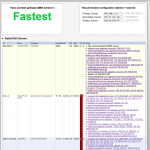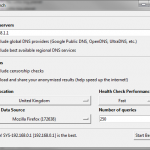
namebench – DNS Tester
There’s a really good DNS benchmark tester called namebench. It’s free (beer and source) and runs on Windows and Mac OSX. The software tests the current DNS as well as popular DNS servers like OpenDNS and Google.
It also has the option to test for blocked / censored sites which maybe usefully to find a more open DNS.
Download and run the software. It will take a while whilst it tests the different DNS and at the end it will produce a HTML report, listing all the DNS in order of speed. Not only does it test DNS servers from companies but goes down each server such as the primary and alternative ones.
The report is comprehensive and quite technical with little to no explanation as to what the column titles mean so I thought I’d try and explain them:
- IP – address of the DNS server which can be used to configure your DNS
- Descr. – description of the DNS server. This will most likely tell you who the DNS server belongs to
- Hostname – label for identifying the server. It’s a more friendly way to display an address than an IP address
- Avg(ms) – average time it took for a DNS query. Lower the better
- Diff – difference from the first DNS. A postive number means it’s faster than the top entry.
- Min – quickest time it took for a DNS query
- Max – slowest time it took for a query
- To –
Don’t knowtime out - NX – A.K.A RCODE is a response code for sites that do not exist. I think the value is the number sites which are “NX Hijacked” which means the DNS is returning a different page to what the site should be. For example when you go to a site which does not exist and your ISP shows it’s own “404” webpage. Example below:
- Notes – Any other information like censored site information or incorrect domain name to IP address (usually means caching)
There is a helpful summary at the top of the page which states whether your current DNS is the fastest or not and what the recommended DNS settings should be.




Hi Danny, Thkx for explaining the meaning of NX. Isn’t TO for the number of TimeOuts? (Not sure what that would mean though!)
Ah Time Outs makes sense. Thanks and I will amend.